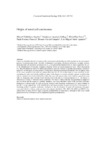Mostrar o rexistro simple do ítem
Origin of renal cell carcinomas
| dc.contributor.author | Valladares-Ayerbes, Manuel | |
| dc.contributor.author | Aparicio Gallego, Guadalupe | |
| dc.contributor.author | Díaz-Prado, Silvia | |
| dc.contributor.author | Jiménez Fonseca, P. | |
| dc.contributor.author | García Campelo, Rosario | |
| dc.contributor.author | Antón-Aparicio, Luis M. | |
| dc.date.accessioned | 2017-08-31T11:37:12Z | |
| dc.date.available | 2017-08-31T11:37:12Z | |
| dc.date.issued | 2008-11-28 | |
| dc.identifier.citation | Valladares Ayerbes M, Aparicio Gallego G, Díaz Prado S, Jiménez Fonseca P, García Campelo R, Antón Aparicio LM. Origin of renal cell carcinomas. Clin Transl Oncol. 2008;10(11):697-712 | es_ES |
| dc.identifier.issn | 1699-048X | |
| dc.identifier.issn | 1699-3055 | |
| dc.identifier.uri | http://hdl.handle.net/2183/19413 | |
| dc.description.abstract | [Abstract] Cancer is a heritable disorder of somatic cells: environment and heredity are both important in the carcinogenic process. The primal force is the “two hits” of Knudson’s hypothesis, which has proved true for many tumours, including renal cell carcinoma. Knudson et al. [1, 2] recognised that familial forms of cancer might hold the key to the identification of important regulatory elements known as tumour-suppressor genes. Their observations (i.e., that retinoblastoma tend to be multifocal in familial cases and unifocal in sporadic presentation) led them to propose a two-hit theory of carcinogenesis. Furthermore, Knudson postulated that patients with the familial form of the cancer would be born with one mutant allele and that all cells in that organ or tissue would be at risk, accounting for early onset and the multifocal nature of the disease. In contrast, sporadic tumours would develop only if a mutation occurred in both alleles within the same cell, and, as each event would be expected to occur with low frequency, most tumours would develop late in life and in a unifocal manner [3, 4]. The kidney is affected in a variety of inherited cancer syndromes. For most of them, both the oncogene/tumour-suppressor gene involved and the respective germline mutations have been identified. Each of the inherited syndromes predisposes to distinct types of renal carcinoma. Families with hereditary predisposition to cancer continue to provide a unique opportunity for the identification and characterisation of genes involved in carcinogenesis. A surprising number of genetic syndromes predispose to the development of renal cell carcinoma, and genes associated with five of these syndromes have been already identified: VHL, MET, FH, BHD and HRPT2. Few cancers have as many different types of genetic predisposition as renal cancer, although to date only a small proportion of renal cell cancers can be explained by genetic predisposition. | es_ES |
| dc.language.iso | eng | es_ES |
| dc.publisher | Springer | es_ES |
| dc.relation.uri | http://dx.doi.org/10.1007/s12094-008-0276-8 | es_ES |
| dc.rights | The final publication is avaliable at Springer Link | es_ES |
| dc.subject | Stem cell | es_ES |
| dc.subject | Stem cell markers | es_ES |
| dc.subject | Bone marrow stem cells | es_ES |
| dc.title | Origin of renal cell carcinomas | es_ES |
| dc.type | info:eu-repo/semantics/article | es_ES |
| dc.rights.access | info:eu-repo/semantics/openAccess | es_ES |
| UDC.journalTitle | Clinical and Translational Oncology | es_ES |
| UDC.volume | 10 | es_ES |
| UDC.issue | 11 | es_ES |
| UDC.startPage | 697 | es_ES |
| UDC.endPage | 712 | es_ES |
Ficheiros no ítem
Este ítem aparece na(s) seguinte(s) colección(s)
-
GI-TCMR - Artigos [130]






